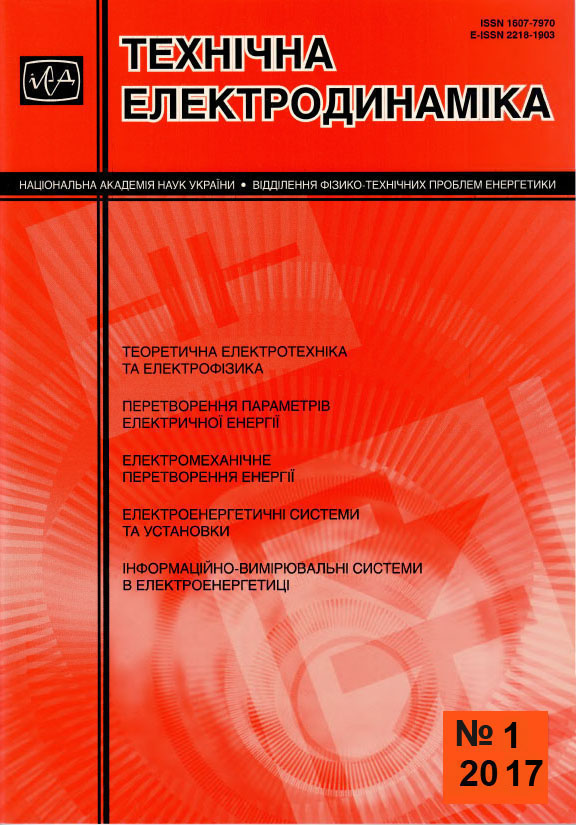Abstract
Matrix converter control method which is based on the general algorithm of input reactive power control and aims to improve the quality of input currents in conditions of unbalanced load and input voltages has been proposed and studied. For this purpose, the process of formation of the matrix converter space vector input current has been considered as a result of the addition of two independent dynamic modulation methods of the input current reactive component. The first one is based on the determination of the transfer ratio of output current into input current under balanced load and unbalanced power supply taking into account symmetric component of negative sequence of the input voltage, and the second one is under unbalanced load taking into account reactive part of symmetric component of negative sequence component of the output current. Operating limits, where the proposed modulation methods are fully realized, have been defined. The effectiveness of the proposed approach confirmed by simulation of matrix converter input currents based on actual switching conditions and discrete formation of these currents. References 13, figures 5.
References
Mykhalskyi V.M., Sobolev V.M., Chopyk V.V., Shapoval I.A. Control of a matrix converter input reactive power // Tekhnichna Elektrodynamika. – 2014. – No 3. – С. 33–41.
Mykhalskyi V.M., Sobolev V.M., Chopyk V.V., Shapoval I.A. Improvement of the input current waveforms of a matrix converter under unbalanced and/or nonsinusoidal input voltage conditions // Tekhnichna Elektrodynamika. – 2015. – No 3. – Pp. 17–24. (Ukr)
Mykhalskyi V.M., Sobolev V.M., Chopyk V.V., Shapoval I.A. Improvement of the input current waveforms of a matrix converter in the case of balanced sinusoidal power supply voltages and unbalanced load // Tekhnichna Elektrodynamika. – 2016. – No 2. – Pp. 29–34. (Ukr)
Akagi H., Watanable E.H., Aredes M. Instantaneous power theory and applications to power conditioning. – Piscataway, NJ: IEEE Press, 2007. – 379 p. 5. Ali S., Wolfs P. An improved modulation method for matrix converters with unbalanced output loading // Proceedings of the 2014 Australasian Universities Power Engineering Conference, AUPEC 2014. – Perth (Western Australia). – 28 September - 1st October 2014. – Pр. 1-6.
Blaabjerg F., Casadei D., Klumpner C., Matteini M. Comparison of two current modulation strategies for matrix converters under unbalanced input voltage conditions // IEEE Trans. on Industrial Electronics. – 2002. – Vol. 49. – No 2. – Pp. 289–295.
Casadei D., Serra G., Tani A. Matrix converter modulation strategies: a new general approach based on space-vector representation of the switch state // IEEE Trans. on Industrial Electronics. – 2002. – Vol. 49. – No 2. – Pp. 370-381.
Casadei D., Serra G., Tani A. A general approach for the analysis of the input power quality in matrix converters // Proc. IEEE-PESC ‘96, Baveno, Italy, June 23-27, 1996. – Vol. II. – Pp. 1128–1134.
Hojabri H., Mokhtari H., Chang L. A generalized technique of modelling, analysis and control of a matrix converter using SVD // IEEE Transactions on Industrial Electronics. – 2011. – Vol. 58. – No 3. – Pp. 949-959.
Igney J., Braun M. A new matrix converter modulation strategy maximizing the control range // Proceedings of the IEEE 35th Annual Power Electronics Specialists Conference, Aachen, Germany. – 2004. – Vol. 4. – Pp. 2875-2880.
Nielsen P., Casadei D., Serra G., Tani A. Evaluation of the input current quality by three different modulation strategies for SVM controlled matrix converters with input voltage unbalance // Proc. of IEEE-PEDES ’96, New Delhi, India, Jan. 8-11, 1996. – Vol. II. – Pp. 794–800.
Xing Li, Mei Su, Yao Sun, Handbing Dan, Wenjing Xiong. Modulation strategies based on mathematical construction method for matrix converter extending the input reactive power range // IEEE Transactions on Power Electronics. – 2014. – Vol. 29. –No 2. – Pp. 654-664.
Zarri L., Mengoni M., Toni A., Ojo J.O. Range of the linear modulation in matrix converters // IEEE Trans. on Power Electronics. – 2014. – Vol. 29. – No 6. – Pp. 3166-3178.

This work is licensed under a Creative Commons Attribution-NonCommercial-NoDerivatives 4.0 International License.
Copyright (c) 2022 Tekhnichna Elektrodynamika

